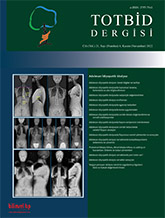
Adolescent idiopathic scoliosis is a three-dimensional deformity of the coronal, sagittal and axial planes. Therefore, the natural state of scoliosis, the results and complications of surgery can be seen in these three planes. In addition, the change of instrumentation techniques used in spine surgery has been especially effective on implant-related complications. In recent years, the success of correcting the deformity has increased with the use of segmental instrumentation techniques, especially with pedicle screws. Surgical correction of rigid and high-grade deformities have become possible via only posterior techniques and the need for osteotomies has reduced. In this way, the practice of spine surgery has become widespread. However, some complications related to surgery or implants have started to be seen more. After spine surgery, degeneration of adjacent segments, bone or soft tissue insufficiency of proximal and distal junctions, increase in kyphosis in the most proximal or distal part of the instrumentation and progression of the scoliotic curve to the distal unfused site can be seen as complications. Knowledge of these conditions, determination of risk factors and correct preoperative plan are important.